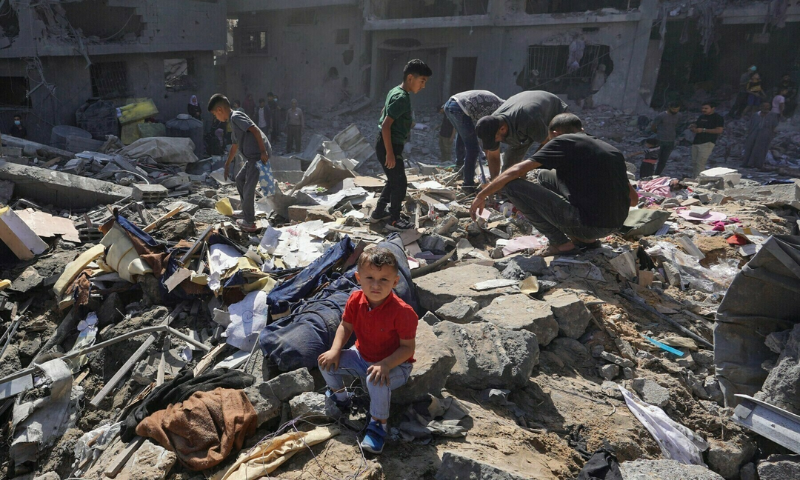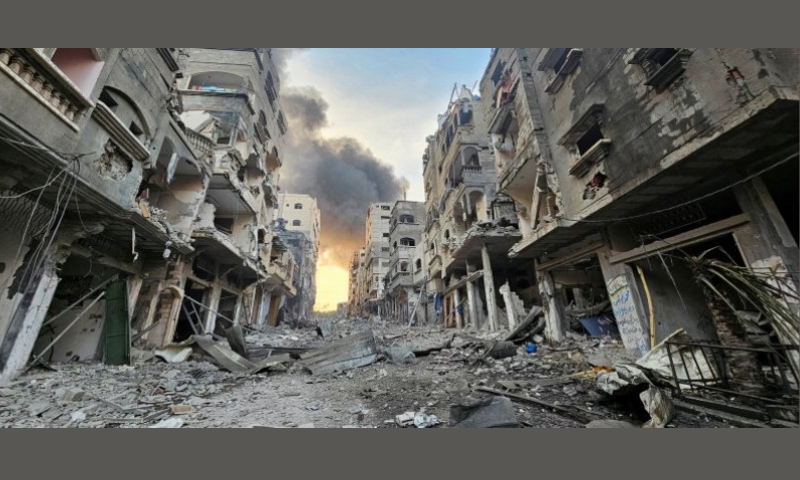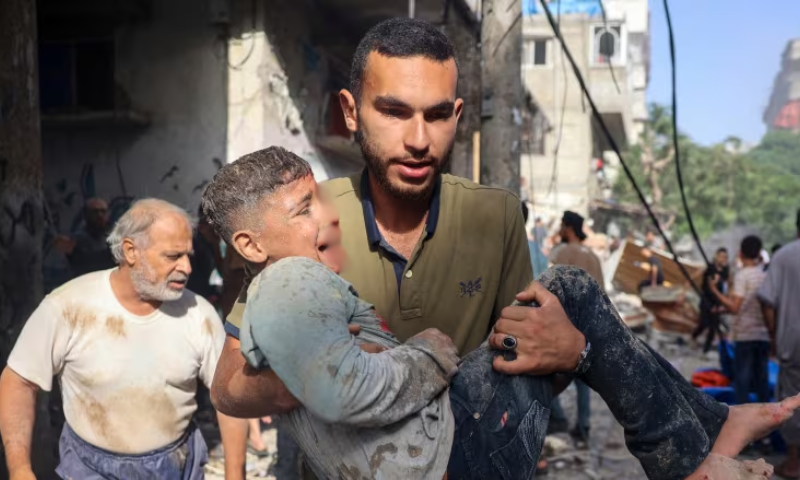UNITED NATIONS: The UN human rights office has said the Israeli military have committed multiple war crimes and has made minimal efforts to protect civilians in its war targeting Palestinians in Gaza.
In a separate session of the UN Human Rights Council in Geneva, the head of a UN Commission of Inquiry indicated that the scale of Palestinian civilian casualties amounted to “extermination.” Navi Pillay, a former South African judge, stated that the use of weapons with large destructive capacities in densely populated areas “constitutes an intentional and direct attack on the civilian population,” and those responsible should be held accountable.
The UN report, focusing on six attacks that resulted in mass casualties and the destruction of civilian infrastructure, indicated that Israeli forces “may have systematically violated” the principles of distinction, proportionality, and precaution. The report noted that no prior warning was issued in five of the attacks, emphasizing that international humanitarian law mandates the protection of civilians as a priority.
“The requirement to select means and methods of warfare that avoid or minimize civilian harm appears to have been consistently violated in Israel’s bombing campaign,” said UN High Commissioner for Human Rights Volker Türk.
The report is based on investigations by the UN human rights office, OHCHR, into six attacks described as “emblematic” of Israeli tactics in the over eight-month conflict. These attacks involved the suspected use of bombs weighing up to 2,000 lbs (920kg) on residential buildings, a school, refugee camps, and a market.
These weapons, measuring approximately 12 feet (3.4 meters) along with smaller versions, were deployed from October 9 to December 2, 2023, resulting in 218 confirmed deaths. The OHCHR noted that the actual number of fatalities is likely much higher.
The report cited an Israeli Defense Forces update on November 11, 2023, stating that the Air Force had “struck over 5,000 targets to eliminate threats in real-time” since the bombing of Gaza began a month earlier. By that time, Gazan health authorities had documented the deaths of 11,078 Palestinians, with another 2,700 missing and approximately 27,490 injured.
Detailing strikes on the Ash Shuja neighborhood in Gaza City, the report’s authors noted that the span of destruction measured approximately 130 meters across, destroying 15 buildings. The extent of the damage indicated the use of approximately nine 2,000 lb GBU-31 bombs that killed at least 60 civilians.
“Israel’s methods and means of conducting hostilities in Gaza since October 7, including the extensive use of explosive weapons with wide-area effects in densely populated areas, have failed to effectively distinguish between civilians and fighters,” the OHCHR report alleged.
“Civilian lives and infrastructure are protected under International Humanitarian Law (IHL). This law clearly obligates parties to armed conflicts to prioritize the protection of civilians.”
Meanwhile, in Gaza, people today are forced to shelter amid “unimaginable” destruction, said Ajith Sunghay, Head of the OHCHR Office in the Occupied Palestinian Territory.
Speaking to journalists via video link from Amman after an assessment mission in multiple locations across the enclave, Sunghay described how Gazans are “barely surviving” after being repeatedly displaced by violence and IDF evacuation orders.
“The hospitals are packed to overflowing and the smell is unbearable…sewage is spilling into tents, there is no clean water…If the bombs don’t kill, disease will,” Sunghay said, after visiting Khan Younis, Rafah, and Deir-Al-Balah.
“The sounds of bombs, guns, and drones are constant,” he added. “The sound of war is non-stop day and night. In my 22 years of work at the U.N., including in many conflict and post-conflict situations, I’ve never seen such challenges for the U.N. and human rights and humanitarian aid partners to operate. The destruction is unimaginable.”
The landscape of Khan Younis is now “changed,” Sunghay continued. “It’s full of completely and partially destroyed buildings, infrastructure. People I met told me how they have moved 10 times…they’re barely surviving.”
The report focuses on Israel but also notes that Palestinian armed groups have continued to fire projectiles toward Israel.
OHCHR spokesperson Ravina Shamdasani echoed those concerns while warning that Israel’s military commanders do not appear to have changed their tactics in Gaza to spare civilians, in line with the laws of war. Shamdasani referenced statements from high-level Israeli officials, including an Israeli military member quoted earlier in the conflict as saying: “You wanted hell, you will get hell.”
“We have seen a continued pattern of such attacks,” Shamdasani continued. “The types of weapons used, the means and manner in which they were used, coupled with statements from Israeli officials, raise serious concerns about compliance with international humanitarian law.”
Shamdasani insisted on the need for independent investigations into the attacks covered by the report to determine whether they constitute war crimes and to hold perpetrators accountable.
“As time passes, it becomes much more difficult to carry out these investigations,” she said. “We call first on the Israeli authorities to take steps to ensure that proper, transparent investigations are held. In the absence of this—and if there is continued impunity—there is a need for international action in this regard as well.”
























![Pakistan is encountering dreadful terrorism and extremism. The government needs to revisit and reconstitute its counterterrorism strategy, which is grounded on popular support guaranteed through consensus in Parliament. Besides, an objective political dialogue among the political parties is the need of the hour for internal political stability and engaging the masses to quash effectively terrorist popular and physical sanctuaries. Indeed, without a consensus among the political parties over the launch of Operation Azm-e-Istehkam to combat the menace of terrorism in the country, it could be counterproductive. Since the United States-led NATO withdrawal from Afghanistan in August 2021, terrorist activities have increased rapidly in the country. The foreign-sponsored terrorist groups are targeting and killing law enforcement agencies' personnel, kidnapping and butchering innocent citizens and killing foreigners, especially Chinese, to spoil and thwart foreign direct investment in the country. Realizing the urgency, the government has initiated a new military operation to combat terrorism and extremism. On June 22, the Central Apex Committee of National Action Plan, chaired by Prime Minister Shehbaz Sharif, approved "Operation Azm-e-Istehkam" to eliminate terrorism and extremism nationwide. The presence of Federal Cabinet members, Chief ministers from all provinces and Gilgit-Baltistan, services chiefs, provincial chief secretaries, and other senior civilian, military, and law enforcement officials in the meeting reveal all the stakeholder's unanimity to reinvigorate and re-energize national counterterrorism campaign through the launch of Operation Azm-i-Istehkam. Operation Azm-e-Istehkam is a multipronged strategy with kinetic and non-kinetic stratagems, i.e., military, diplomatic, legislative, and socioeconomic plans to decisively defeat terrorism and extremism. "Azm-i-Istehkam will integrate and synergize multiple lines of effort to combat the menaces of extremism and terrorism comprehensively and decisively." The Pakistan Army has been bravely fighting with the terrorists since the 2009 Swat operation, but the diplomatic tier of the counterterrorism strategy was less effective. Operation Azm-e-Istehkam drives Islamabad to approach diplomatically likeminded states and coordinate with Shanghai Cooperation Organization’s Regional Anti-Terrorist Structure (RATS) to terminate the foreign financial and material support to terrorist groups such as Taliban (TTP), Balochistan Liberation Army (BLA), Daish (Islamic State Khorasan) involved in the terrorist attacks in the country. The Operation Azm-e-Istehkam is the need of the hour. Ironically, even before the launch of the operation, it received a divisive response from the parliamentarians due to the extreme polarization in the Pakistani polity. Pakistan Tehreek-e-Insaf members fiercely opposed the operation’s starting without the prior approval of the Parliament. The PTI Chairman Barrister Gohar said, "Any military operation must involve parliamentary consent. Parliament is supreme under the Constitution." In the parliamentary system of government, like the Pakistani political system, if the Cabinet approves any policy, including military operations, it is assumed that the majority in the Assembly endorses the decision. However, the opposition can call an in-camera session in the Parliament, even over sensitive issues. Defense Minister Khawaja Asif, instead of pacifying opposition lawmakers through dialogue or engagement, reacted viciously on the floor of the National Assembly. He said, “They (the opposition) are standing with the terrorists by protesting here today. They are protesting against the martyrs of the Pakistan Army and the army that is still making sacrifices to [counter] terrorism. They have not backed off from their May 9 stance even today.” Such a response to the PTI lawmakers in the National Assembly, particularly by the Defense Minister, increases disharmony and divisiveness in the Pakistani polity and negatively affects the operation. However, later, rationality prevailed, and Khawaja Asif said that the decision to conduct the operation would go "through the process," including a debate in Parliament’s in-camera session. He said, "It will go through the cabinet, then it will be presented in the House, and the House would be briefed.” One can expect a similar prudent response from the PTI leadership within and outside the Parliament. However, the statements of the PTI leaders are not encouraging. PTI leader Qaiser said, "Our belief is that a military operation is not the solution. All political parties must play their role to establish peace in the province." He is ignoring the fact that the battle-hardened foreign sponsored terrorist groups necessitate kinetic action. In the present pessimistic political situation, Pakistan Peoples Party chairman Bilawal Bhutto-Zardari’s visionary recommendation has germinated optimism. On June 21, he drew attention to the cardinal cause of the internal insecurity: “The politics of hatred in Islamabad is at its peak.” He rightly called for a dialogue among all democratic forces to take the country out of the crisis. He said, "There're many leaders who're not even ready to talk. They don't want to even shake hands with each other. I urge them all once again that all political parties, whether they're in the government or opposition, initiate dialogue with all political forces. Don't let your ego or personal issues dominate this process. If you want to bring Pakistan out of economic crisis and strengthen the Parliament, you would have to talk to democratic forces." Indeed, the country's stability is out of the question without swapping enmity with amity among the political forces. Thus, the political leaders, especially PML-N and PTI, should listen to Mr. Bilawal and initiate a respectful and civilized discussion to steer the country out of the numerous crises, including extremism and militancy. To conclude, a consensual national strategy to combat the menace of terrorism is impossible without recuperating the tumultuous landscape of Pakistani politics. Indeed, the government is responsible for engaging the opposition on the national security issue. Conversely, the opposition party realizes its duty to provide an alternative vision and policy instead of adopting a rejectionist approach.](https://wenewsenglish.pk/wp-content/uploads/2024/06/apex-2-300x180.jpg)
